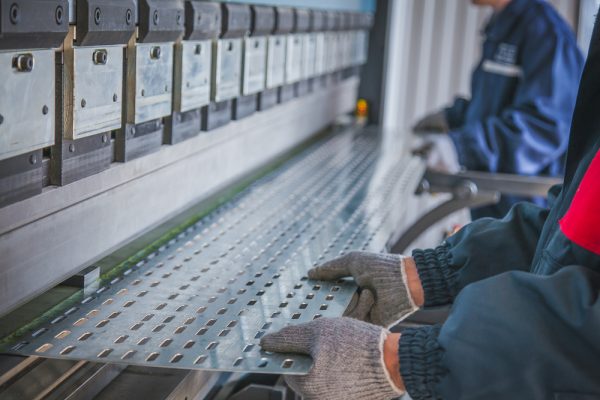Metal fabrication processes: Different types
Metal fabrication processes include molds, cuts, and shapes that enable the metal material to turn into the final product. Apart from the end product, you must assemble it from readymade components. Fabrication enables you to get the end product from semi-finished or raw materials. To help you learn more about the different types of metal fabrication processes, we will discuss them below.
Different types of metal fabrication processes
1. Extrusion
Extrusion is one of the metal fabrication processes in which the workpiece is forced around or through the closed and open die. While forcing through the closed or open die, the workpiece diameter can be reduced to the cross-section of a die. When being pressed around the die, a cavity will form in the workpiece.
Both processes will require the use of a cylinder or a metal slug as a workpiece, and a ram will help in performing the impact operation. The cylindrical product item is generally piping or wiring. In the cross-section die, there can be a lot of different shapes for producing different parts. Extrusion can help in creating long pieces or semi-continuous ones for creating short pieces.
It is also like cold extrusion, the impact extrusion generally occurs at room temperature and enhances the strength of a part that makes it more strong in comparison to the original material. When you apply enough force to the right metal, it will start to flow in the shape that is available similar to the viscous liquid movement.
On the other hand, hot extrusion is performed at a high temperature to prevent the metal from hardening. And it will also make it convenient to move through the die. It is normally in use to make custom aluminum parts and for copper fabrication.
2. Cutting
It is a common metal fabrication process where the cutting workpiece is split into some small sections. Sawing is one of the oldest methods when it comes to cutting. Modern methods comprise plasma arc cutting, laser cutting, power scissors, and water jet cutting. There are several kinds of cutting, from power and manual tools to CNC or computer numerical cutters. Cutting can be the first stage in a lengthy fabrication process or the only process that gets used.
Die cutting is a kind of cutting process that uses a die for slicing metal. Rotary die cutting makes use of a spinning cylindrical die for cutting a material that is fed through the press. Flatbed die cutting is useful for thicker metal materials and uses a die on the press for cutting out the shapes while the die stamps on the metal.
3. Welding
Welding is the process by which you join materials. These mostly include metals such as stainless steel, aluminum, steel, and cast iron. They together use pressure and high heat. There are several welding methods that are available such as shielded metal arc welding (SMAW), tungsten inert gas (TIG), flux-colored arc welding (FCAW), and metal inert gas (MIG) welding. All of these require different skills and welding materials. Manufacturers can use the resources of a robotic or manual welding company based on the complexity and the size of the project of welding.
4. Machining
Machining is more like a subtractive process. This means it can create products and parts by removing the material from your workpiece. Though some manufacturers make use of machining technologies that are manual, people are now turning towards machining equipment that is computer controlled. This will provide a fast speed of processing and great consistency.
Two common CNC machining processes are CNC turning and milling. Operations of CNC milling depend on the rotation of multi-point tools cutting to remove excess metal from the workpiece. Even though the process is similar to a finishing procedure, manufacturers can use it to complete a whole project. Operations of CNC turning use cutting, single-point tools for removing material from the surface of the rotating workpiece. This process is best for creating cylindrical components with precise external and internal elements.
5. Metal stamping
Metal stamping is quite unique for sheet metals such as copper, brass, aluminum, stainless steel, and some galvanized alloys. This process is much distinct for sheet metals, and it can also be used along with some fabrication methods to get the desired outcome. One of the common uses for metal stamping is seen in the assembly and manufacturing of automotive components.
This method helps mainly to design vehicle components such as –
- firewalls
- trunk lids
- doors
- wheel hubcaps and other parts of the vehicle body.
Another reason metal stamping is suitable for automotive purposes is that you can use it with custom-built, unique designs. Enthusiasts of cars can benefit from this method for designing specialty parts for vehicles with high performance.
6. Casting
Casting uses the process of heating metals until it reaches the melting point and pouring it into the mold of an empty cavity to get a particular design. The metal is allowed for cooling until it hardens completely and can be post-processed to improve the metal finish and remove minor defects. An advantage that casting has over other processes is that you can use it for making complex shapes in one single run.
One can cast farming, automotive, computer equipment, and aerospace with minimum issues. The only disadvantage is that the cooling and heating processes may create some internal stress in the metal’s crystal structure. Thus, manufacturers must conduct careful casting operations to prevent damage and cracks on the metal.
Conclusion
Different kinds of metal fabrication processes can be used for different purposes. For instance, manufacturers can use cutting for the slicing of a metal. In addition, you can use welding for complex processes. Stamping helps to create special parts of a vehicle’s body. Machining, on the other hand, is of two types- turning and milling; it will help provide proper consistency and speed.
Crescocustommetals.com is a website where you can get different types of metal fabrication processes that will make your company grow in no time.



